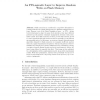Free Online Productivity Tools
i2Speak
i2Symbol
i2OCR
iTex2Img
iWeb2Print
iWeb2Shot
i2Type
iPdf2Split
iPdf2Merge
i2Bopomofo
i2Arabic
i2Style
i2Image
i2PDF
iLatex2Rtf
Sci2ools
142
click to vote
DASFAA
2011
IEEE
2011
IEEE
An FTL-Agnostic Layer to Improve Random Write on Flash Memory
Flash memories are considered a competitive alternative to rotating disks as non-volatile data storage for database management systems. However, even if the Flash Translation Layer – or FTL – allows both technologies to share the same block interface, they have different preferred access patterns. Database management systems could potentially benefit from flash memories as they provide fast random access for read operations although random writes are generally not as efficient as sequential writes. In this paper, we propose a simple data placement algorithm designed for flash memories, to reorganize inefficient random writes in a quasi-sequential access pattern. This access pattern is first established encouraging for a subset of flash devices by identifying a strong correlation between spatial locality and write performances, with a distance being defined to quantify this effect. This design is then validated by a formalization with a mathematical model, along with experim...
Related Content
| Added | 20 Aug 2011 |
| Updated | 20 Aug 2011 |
| Type | Journal |
| Year | 2011 |
| Where | DASFAA |
| Authors | Brice Chardin, Olivier Pasteur, Jean-Marc Petit |
Comments (0)

